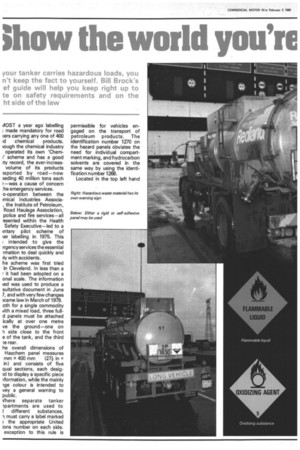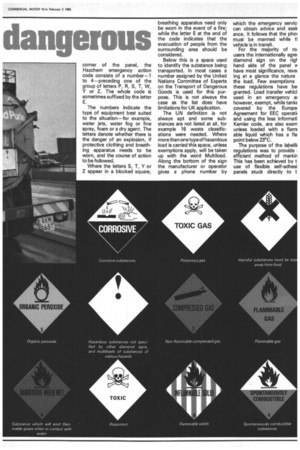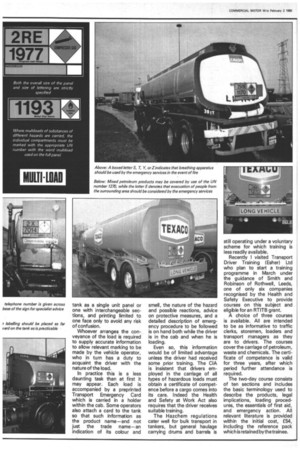;how the world you're dangerous
Page 72

Page 73

Page 74

If you've noticed an error in this article please click here to report it so we can fix it.
OOST a year ago labelling made mandatory for road cers carrying any one of 400
!d chemical products. lough the chemical industry operated its own 'Chem!' scheme and has a good :ty record, the ever-increasvolume of its products Isported by road—now 3eding 40 million tons each r —was a cause of concern :he emergency services.
o-operation between the .mical Industries Associa, the Institute of Petroleum, Road Haulage Association, police and fire services—all .esented within the Health Safety Executive—led to a intary pilot scheme of cer labelling in 1975. This ; intended to give the :rgency services the essential rmation to deal quickly and :ly with accidents.
he scheme was first tried in Cleveland. In less than a it had been adopted on a onal scale. The information led was used to produce a sultative document in June 7, and with very few changes ?came law in March of 1979. oth for a single commodity vith a mixed load, three full d panels must be attached ically at over one metre ve the ground—one on I side close to the front e of the tank, and the third le rear.
he overall dimensions of Hazchem panel measures mm x 400 mm (274 in x in) and consists of five qual sections, each desigKI to display a specific piece formation, while the mainly ige colour is intended to vey a general warning to public.
/here separate tanker vartments are used to different substances, I must carry a label marked the appropriate United ions number on each side. exception to this rule is permissible for vehicles engaged on the transport of petroleum products. The identification number 100 on the hazard panels obviates the need for individual compartment marking, and hydrocarbon solvents are covered in the same way by using the identification number 1268.
Located in the top left hand corner of the panel, the Hazchem emergency action code consists of a number-1 to 4 —preceding one of the group of letters P, R, S, T, W, Y or Z. The whole code is sometimes suffixed by the letter E.
The numbers indicate the type of equipment best suited to the situation—for example, water jets, water fog or fine spray, foam or a dry agent. The letters denote whether there is the danger of an explosion, if protective clothing and breathing apparatus needs to be worn, and the course of action to be followed.
Where the letters S, T, Y or Z appear in a blocked square, breathing apparatus need only be worn in the event of a fire; while the letter E at the end of the code indicates that the evacuation of people from the surrounding area should be considered.
Below this is a space used to identify the substance being transported. In most cases a number assigned by the United Nations Committee of Experts on the Transport of Dangerous Goods is used for this purpose. This is not always the case as the list does have limitations for UK application.
The UN definition is not always apt and some substances are not listed at all, for example 16 waste classifications were needed. Where more than on e type of hazardous load is carried this space, unless exemptions apply, will be taken up with the word Multiload. Along the bottom of the sign the manufacturer or operator gives a phone number by which the emergency servio can obtain advice and assis. ance. It follows that the phoi must be manned while tl vehicle is in transit.
For the majority of roi users the internationally agrel diamond sign on the riglhand side of the panel v. have most significance, revei ing at a glance the nature the load. Few exemptions these regulations have be. granted. Load transfer vehicl used in an emergency al however, exempt, while tan kE covered by the Europe. Agreement for EEC operatii and using the less informati Kemler code, are also exem unless loaded with a flamr able liquid which has a fla point below 23°C.
The purpose of the Iabellii regulations was to provide efficient method of markin This has been achieved by t use of flexible self-adhesi panels stuck directly to t tank as a single unit panel or one with interchangeable sections, and printing limited to one face only to avoid any risk of confusion.
Whoever arranges the conveyance of the load is required to supply accurate information to allow relevant marking to be made by the vehicle operator, who in turn has a duty to acquaint the driver with the nature of the load.
In practice this is a less daunting task than at first it may appear. Each load is accompanied by a preprinted Transport Emergency Card which is carried in a holder within the cab. Some operators also attach a card to the tank so that such information as the product name—and not just the trade name—an indication of its colour and smell, the nature of the hazard and possible reactions, advice on protective measures, and a detailed description of emergency procedure to be followed is on hand both while the driver is in the cab and when he is loading.
Even so, this information would be of limited advantage unless the driver had received some prior training. The CIA is insistent that drivers employed in the carriage of all types of hazardous loads must obtain a certificate of competence before a cargo comes into its care. Indeed the Health and Safety at Work Act also requires that the driver receives suitable training.
The Hazchem regulations cater well for bulk transport in tankers, but general haulage carrying drums and barrels is still operating under a voluntary scheme for which training is less readily available.
Recently I visited Transport Driver Training (Esher) Ltd who plan to start a training programme in March under the guidance of Smith and Robinson of Rothwell, Leeds, one of only six companies recognised by the Health and Safety Executive to provide courses on this subject and eligible for an RTITB grant.
A choice of three courses is available. All are intended to be as informative to traffic clerks, storemen, loaders and transport managers as they are to drivers. The courses cover the carriage of petroleum, waste and chemicals. The certificate of competence is valid for three years, after which period further attendance is required.
The two-day course consists of ten sections and includes the basic terminology used to describe the products, legal implications, loading procedures, the essentials of first aid, and emergency action. All relevant literature is provided within the initial cost, £54, including the reference pack which is retained bythetrainee.








































































































































